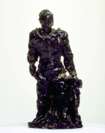 |
 |
Cyclist |
|
 |
After a failed attempt to set up
his own ceramics studio in Val Ganna, which ended in 1947, he settled in Albisola. In this
town in Liguria, where he re-established contact with his friend Tullio Mazzotti who
allowed him to use his own ceramics factory, Sassu began a long period of work, going from
1948 to 1960-61. Among the other artists
working there in this same period were Fontana, Agenore Fabbri, Angelo Del Bon, and later Roberto Crippa, Enrico
Baj, Sergio Dangelo, Wildredo Lam, as well as members of the Cobra group: Asger Jorn,
Guillaume Corneille, and Karel Appel. Some of these are represented in the mural Cronache
di Albisola, painted in oils in 1948 and since dismantled. |
 |
|
 |
Sassu, Fontana, and Fabbri, thanks
to their architect friend Osvaldo Borsari, obtained numerous orders for objects for home
furnishings like ceramic handles, plates, and small decorative sculptures. His stay in Albisola gave Sassu the opportunity to carry out an
extremely diversified artistic activity: he made ceramic works, in which the theme of the horse prevailed; resumed his experiments with sculpture, begun with the Cyclist of 1939, where he united the sense of the malleability of the
material with his unending research into the concreteness of things and figures in space;
and in the sphere of painting he continued his effort, begun in the 1930s, to work out a
personal language attentive both to contemporary reality and to myth. |

